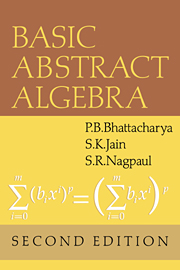Preface to the first edition
Published online by Cambridge University Press: 05 June 2012
Summary
This book is intended for seniors and beginning graduate students. It is self-contained and covers the topics usually taught at this level.
The book is divided into five parts (see diagram). Part I (Chapters 1–3) is a prerequisite for the rest of the book. It contains an informal introduction to sets, number systems, matrices, and determinants. Results proved in Chapter 1 include the Schröder–Bernstein theorem and the cardinality of the set of real numbers. In Chapter 2, starting from the well-ordering principle of natural numbers, some important algebraic properties of integers have been proved. Chapter 3 deals with matrices and determinants. It is expected that students would already be familiar with most of the material in Part I before reaching their senior year. Therefore, it can be completed rapidly, skipped altogether, or simply referred to as necessary.
Part II (Chapters 4–8) deals with groups. Chapters 4 and 5 provide a foundation in the basic concepts in groups, including G-sets and their applications. Normal series, solvable groups, and the Jordan–Hölder theorem are given in Chapter 6. The simplicity of the alternating group An and the nonsolvability of Sn, n > 4, are proved in Chapter 7. Chapter 8 contains the theorem on the decomposition of a finitely generated abelian group as a direct sum of cyclic groups, and the Sylow theorems. The invariants of a finite abelian group and the structure of groups of orders p2, pq, where p, q are primes, are given as applications.
- Type
- Chapter
- Information
- Basic Abstract Algebra , pp. xiv - xviiPublisher: Cambridge University PressPrint publication year: 1994



